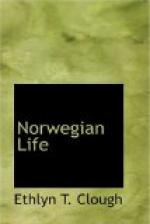A great number of maggots were bred in Ymer’s body, and they became gnomes or dwarfs, little beings whom the gods gave human sense and appearance. They lived within the mountains, and were skilful metal-workers, but they could not endure the light of day. Four dwarfs, the East, West, North, and South, were placed by the gods to carry the arch of heaven.
As yet there were no human beings on earth. Then, one day, the three gods, Odin, Keener and Lodur, were walking on the shore of the sea, where they found two trees, and from them they made the first man and the first woman, Ask and Embla (ash and elm). Odin gave them life, Hoener reason, Lodur blood and fair complexion. The gods gave them Midgard for a home, and from them the whole human race is descended.
The evergreen ash tree Ygdrasil is the finest of all trees. It shoots up from three roots. One of them is in the well Hvergelmer in Niflheim, and on this the dragon Nidhugger is gnawing. The other root is in Yotunheim, in the wise Yotun Mimer’s fountain. One of Odin’s eyes, which he pledged for a drink at this fountain, is kept here. Whoever drinks of this fountain becomes wise. The third root is in heaven, at the Urdar well, where the gods hold their Thing or court. To this place they ride daily over the bridge Bifrost. Here also the three Norns abide, the maidens Urd, Verdande, and Skuld (past, present, and future). They pour water from the well over the roots of the tree. The Norns distribute life and govern fate, and nothing can change their decision.
The dwelling in heaven of the Aesir or gods is called Asgard. In its middle was the field of Ida, the gathering-place of the gods, with Odin’s throne, Lidskialv, from which he views the whole world. Odin is the highest and the oldest of the gods, and all the others honor him as their father. Odin’s hall is Valhalla. The ceiling of this hall is made of spears, it is covered with shields, and its benches are ornamented with coats of mail. To this place Odin invites all who have fallen in battle, and he is therefore called Valfather, i.e., the father of the fallen. The invited fallen heroes are called Einherier; their sport and pastime is to go out every day and fight and kill each other; but toward evening they awake to life again and ride home as friends to Valhalla, where they feast on pork of the barrow Saerimmer, and where Odin’s maidens, the Valkyrias, fill their horns with mead. These Valkyrias were sent by Odin to all battles on earth, where they selected those who were to be slain and afterward become the honored guests at Valhalla. At Odin’s side sit the two wolves, Gere and Freke, and on his shoulders the ravens, Hugin and Munin. These ravens fly forth every morning and return with tidings from all parts of the world. Odin’s horse is the swift, gray, eight-footed Sleipner. When he rides to battle he wears a golden helmet, a beautiful coat of mail, and carries the spear Gungner, which never fails. Odin is also the god of wisdom and poesy; in the morning of time he deposited one of his eyes in pledge for a drink of Mimer’s fountain of wisdom, and he drank Suttung’s mead in order to gain the gift of poesy. He has also taught men the art of writing Runes and all secret arts.




